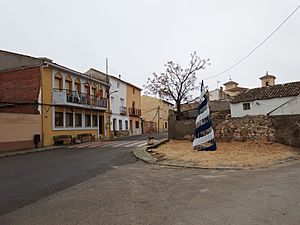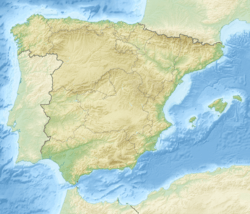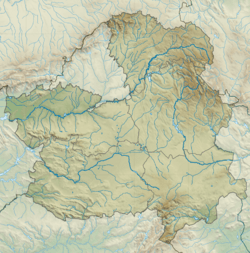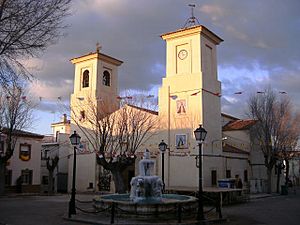Zarza de Tajo facts for kids
Quick facts for kids
Zarza de Tajo
|
||
|---|---|---|
 |
||
|
||
| Country | Spain | |
| Autonomous community | Castile-La Mancha | |
| Province | Cuenca | |
| Population
(2018)
|
||
| • Total | 229 | |
| Time zone | UTC+1 (CET) | |
| • Summer (DST) | UTC+2 (CEST) | |
Zarza de Tajo is a small and charming municipality located in the beautiful province of Cuenca, within the region of Castile-La Mancha, Spain. It's a quiet place where around 254 people live, making it a close-knit community.
Contents
Discover Zarza de Tajo!
Zarza de Tajo is a lovely village that offers a glimpse into traditional Spanish life. It's known for its peaceful atmosphere and the friendly people who call it home.
Where is Zarza de Tajo Located?
This municipality is found in the central part of Spain. It's part of the Province of Cuenca, which is in the larger autonomous community of Castile-La Mancha. This region is famous for its wide-open spaces, historic towns, and the setting of the famous novel Don Quixote. Zarza de Tajo is nestled in this scenic area, not too far from the Tagus River, which gives the town its name ("Tajo" is the Spanish name for the Tagus River).
What's Life Like in Zarza de Tajo?
With a population of just over 250 people, Zarza de Tajo is a very small town. This means life here is often calm and peaceful. People usually know their neighbors, and there's a strong sense of community. The main activities often revolve around local traditions, farming, and enjoying the quiet countryside. It's a great place to experience a slower pace of life away from big cities.
Exploring Local Landmarks
One of the most important buildings in Zarza de Tajo is its church. Like many old Spanish towns, the church is often the heart of the community and a place where people gather for celebrations and events. These churches often have interesting architecture and tell stories about the town's history.
A Glimpse into History
Like many towns in Spain, Zarza de Tajo has a long history, stretching back many centuries. Over time, it has seen different cultures and events shape its development. While it might not have huge battles or famous kings associated with it, its history is woven into the everyday lives of its people and the old buildings that still stand.
See also
 In Spanish: Zarza de Tajo para niños
In Spanish: Zarza de Tajo para niños





